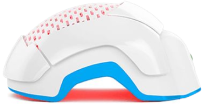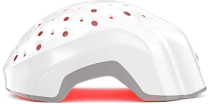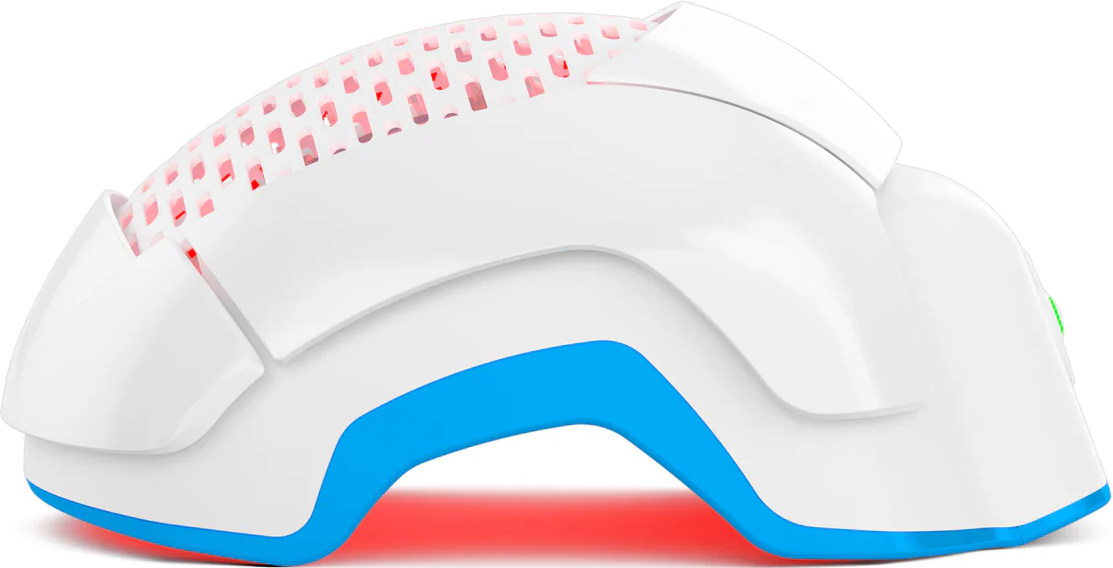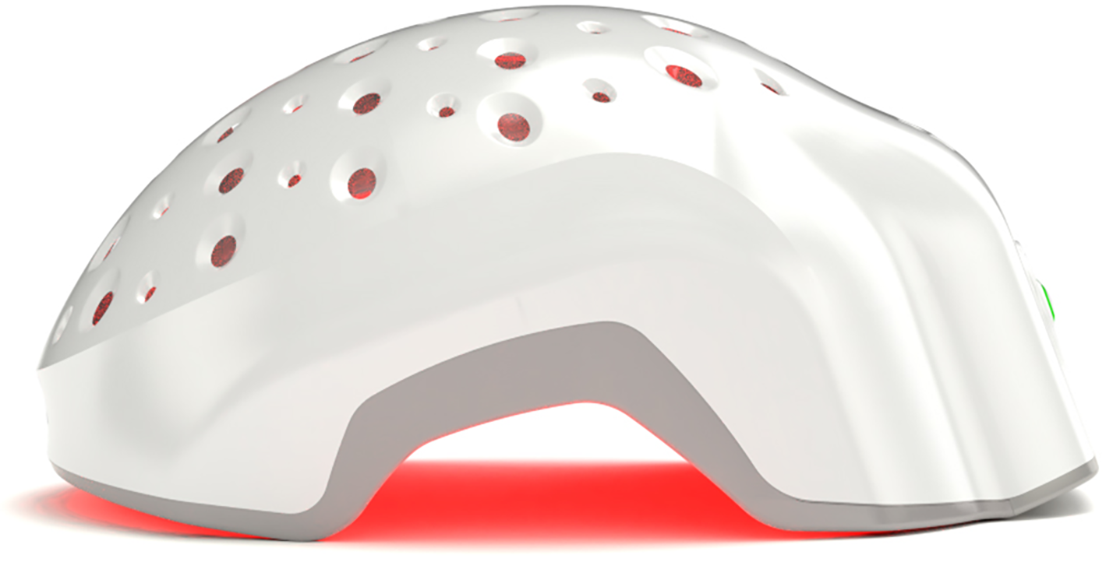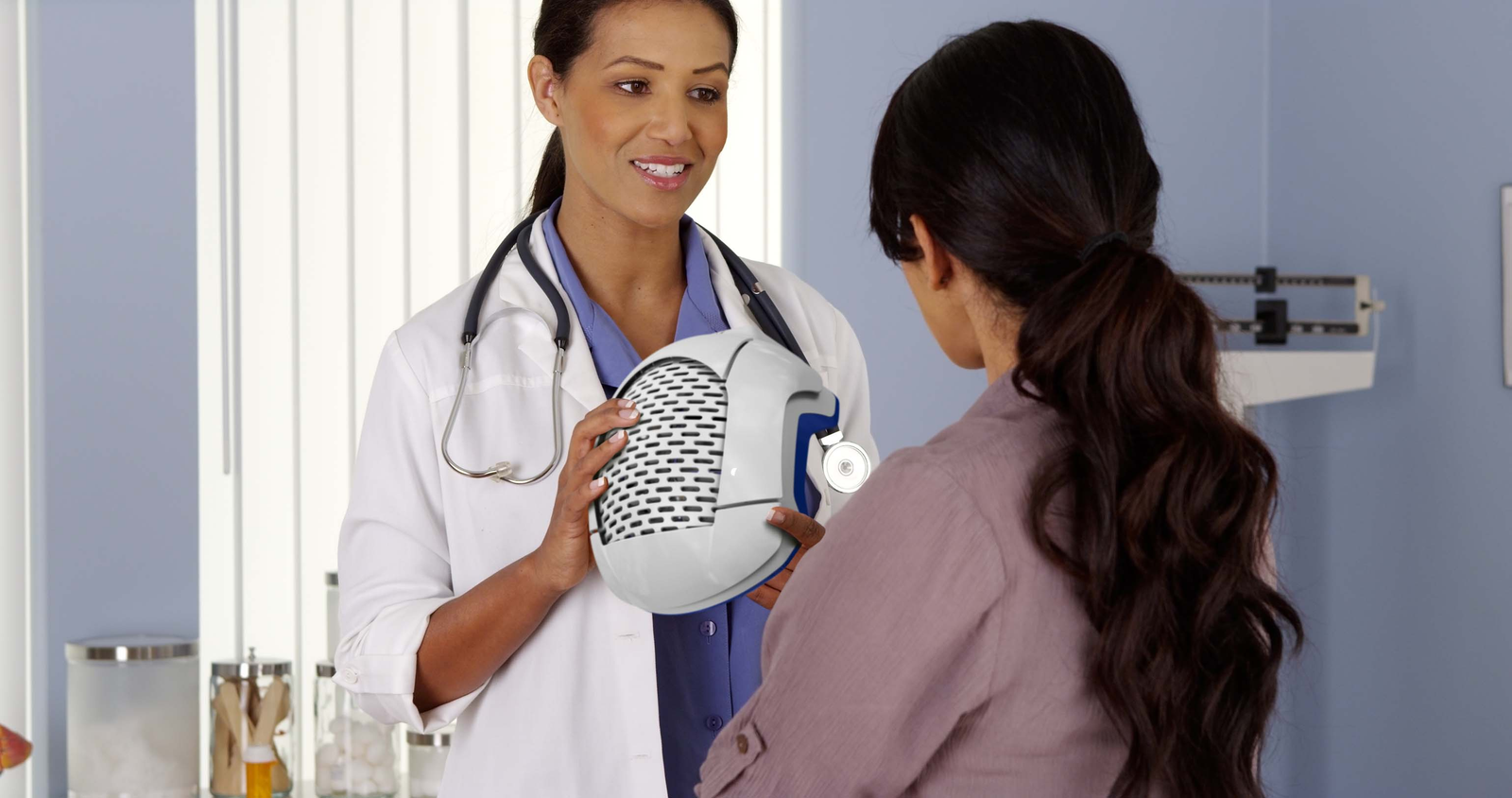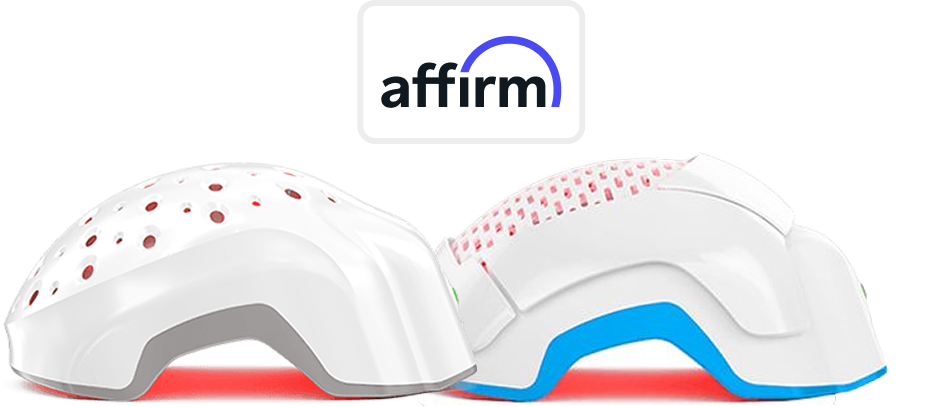Lasers are 60,000 times stronger than LEDs.
And that’s the key point Theradome drives home in its laser vs. LED explainer video below. The visual analogy is sharp (almost literally): laser light, like the needle of a syringe, pushes deep beneath the scalp’s dense outer layer to reach the hair follicle’s regenerative core. LEDs, on the other hand, scatter like lotion on skin. No matter how hard you press, they just don’t go deep enough to matter. The video walks us through the three must-haves for follicle stimulation: coherence (focused light), precise wavelength (Theradome’s 680nm red laser), and energy density (where lasers outclass LEDs by orders of magnitude). It’s physics. And when regrowth depends on stimulating follicle stem cells beneath the surface (not just lighting up the scalp), coherence wins. Every time.
If you’re sorting through helmets that “glow,” this distinction matters because only laser phototherapy reaches the living follicle tissue that needs stimulating. You’d need almost 5 million LEDs to equal what 80 Theradome lasers deliver.
If you're among the 50% of Americans struggling with hair loss, you've likely heard about Laser and LED therapy for hair growth. Both treatments may sound the same, but they are totally different and have their own effectiveness, benefits, and considerations. By understanding the contrasts between LED and Laser for hair growth, you can choose the option that suits your needs and goals.
In the past few years, you've likely heard about Low-Level Laser Therapy(LLLT). LLLT is also referred to as Laser Phototherapy (LPT) and laser light therapy for hair growth. After all, it carries a big promise! Laser hair growth treatment has the power to stop hair loss, thicken existing hair, and grow new hair. Pretty incredible, huh? It's no wonder that LLLT helmets have flooded the market in the past few years. Ideally, these devices provide clinical-strength therapy and results from the comfort of your own home.
Laser Therapy and LED(Light-emitting Diode) Therapy both use light to stimulate hair growth, but they work in slightly different ways. However, Laser tends to be more effective than LED for hair growth because it uses a focused, single wavelength of light that can penetrate deeper into the scalp, reaching the hair follicles more efficiently. LED, on the other hand, uses a broader range of wavelengths and is generally less powerful, which might result in slower or less noticeable results. In this article, we'll look at the detailed comparison between LED vs. Laser for hair growth to help you decide which is best for you.
How Does Light Therapy Work for Hair Growth?
Light therapy, whether from red LED light or laser devices, works to promote hair growth by delivering specific wavelengths of light energy to the scalp. This light energy is absorbed by the cells in the hair follicles, which can stimulate them to produce more proteins and increase blood flow. The light therapy also reduces inflammation and oxidative stress, two key factors contributing to hair loss. By targeting these root causes, light therapy aims to stop shedding and enable the hair to regrow naturally.
If you’re experiencing thinning hair or hair loss, it means your hair follicles are no longer functioning optimally or getting the energy they need. This is where your mitochondria come in. Mitochondria are the power plants of your cells. And when they are revived or restimulated, your hair stays intact, and new hair can grow.
The challenge is that your hair follicles are deep below the surface, and restoring them requires a precise dose of energy.
Laser hair growth treatment must be able to penetrate your scalp all the way to the hair follicle, with the right type of light therapy for growth, in the right wavelength, and with enough power.
3 Key Factors in Laser vs LED For Hair Growth Treatments

When you're trying to decide between laser and LED light therapy for hair growth treatment, there are a few important things to consider. As you might imagine, lasers and LEDs(Light Emitting Diodes) produce very different outcomes when it comes to hair restoration. Let's take a closer look at the three main factors that can impact the effectiveness of Laser and LEDs for hair growth.
1. Light Coherence Comparison: Lasers vs LEDs
There is a notable distinction in the light emission between laser and LED(Light Emitting Diode). Lasers emit monochromatic and coherent light, meaning it is a single-color wavelength, and the light waves are in phase.
The single wavelength makes laser light ideal for medical treatments because certain tissues (including hair follicles) only respond to particular wavelengths of light. Laser light’s coherence keeps the energy focused and the beam narrow so that it can effectively penetrate deeper into the scalp and reach your hair follicles.
Lasers emit coherent light, meaning all the light waves are aligned and focused at the required wavelength of 680nm. The coherence beam of lasers penetrates deeper into the scalp, effectively reaching and stimulating hair follicles for healthy hair growth. On the other hand, LEDs produce a wider, non-coherent light that spreads out and doesn't penetrate as deeply, making them less effective for hair growth than lasers.
2. Wavelength Comparison: Lasers vs LEDs
According to the Swedish Laser Medical Society, 680 nm is the optimal wavelength of light for reaching and stimulating hair follicle cells. Only lasers can reach this necessary wavelength for hair growth when compared to LEDs. Since lasers deliver light at one specified wavelength, they can be targeted specifically for this wavelength.
Because LEDs are neither monochromatic nor coherent, they cannot target this very specific wavelength, and their beams do not actually reach the hair follicle. This makes them therapeutically useless when it comes to hair restoration.
3. Power Comparison: Lasers vs. LEDs
The final factor to consider when comparing LED and laser for hair growth treatment is power. In order to effectively stimulate hair follicles, you need enough energy to reach them to produce a photobiomodulation effect.
Well, energy = power X time. And since light becomes more dispersed the farther it travels, you need a significant amount of power for the light to be strong enough once it reaches your hair follicle cells.
Additionally, since energy = power X time, the more powerful the laser, the more energy is produced and in a shorter amount of time. This means that powerful lasers are not only more effective, they produce results in less time.
Lasers produce far more power than what LEDs are capable of. To put it plainly, LEDs are simply not powerful enough to have a therapeutic effect when it comes to hair growth. To be specific, a laser can deliver about 150 times more joules than an LED, which means deeper penetration and at 680 nm wavelengths, this provides even deeper penetration. Hence, in terms of power comparison too, laser is far more effective for hair growth than LED therapy.
LED Light Therapy For Hair Growth
LED (Light Emitting Diode) light hair loss therapy is a non-invasive treatment that uses specific wavelengths of LED light to stimulate hair growth and combat hair loss. It is a form of Low-Level Laser Therapy (LLLT) and is often referred to as "LED LLLT" or "LED Red Light Therapy" when used for hair loss.
The therapy works similar to Red Light Therapy, but instead of using lasers, it employs LED lights that emit specific wavelengths of red or near-infrared light. These wavelengths are believed to penetrate the scalp and hair follicles, promoting cellular activity and improving blood circulation in the area. The increased blood flow can deliver more oxygen and nutrients to the hair follicles, potentially stimulating growth and improving hair health.
Why Do Companies Use Red Light LEDs Instead of Lasers for Hair Loss Treatment?
Many companies choose to cut costs by using LEDs exclusively or a mix of lasers and LEDs for hair growth. LEDs are inexpensive and easy to make. That’s why red LEDs are often used as on-off indicators in electronic devices. Lasers, on the other hand, are more expensive than LEDs, as they produce an intense beam of light and meet scientific-grade standards.
How Does LED light therapy for hair growth work?
LED Light Therapy utilizes specific wavelengths of red or near-infrared light to stimulate cellular activity in the scalp and hair follicles. The light energy is believed to trigger various biological responses that may promote hair growth and improve the overall health of the hair. Here's how LED light therapy for hair regrowth works:
1. Penetration of Light
LEDs devices emit specific wavelengths of light, typically red or near-infrared spectrum. These wavelengths can penetrate the skin and reach hair follicles and underlying tissues without generating heat or causing damage to the skin.
2. Stimulation of Cellular Activity
Once the red and near-infrared light is absorbed by the cells in the scalp and hair follicles, it stimulates cellular activity and energy production within the mitochondria. This process is called photobiomodulation, where the light energy is converted into cellular energy (ATP).
3. Improved Blood Circulation
LED light therapy is believed to enhance blood circulation in the treated area, delivering more oxygen and nutrients to hair follicles. This help in reviving dormant or weakened follicles.
4. Reduction of Inflammation
LED light therapy may have anti-inflammatory effects, reducing scalp inflammation. LED therapy potentially supports healthier hair growth since inflammation is mitigated by LED therapy which is associated with certain types of hair loss.
5. Proliferation of Hair Cells
The light energy is considered to stimulate the proliferation of hair cells, which promotes the development of new hair strands and strengthens existing ones.
6. Extended Growth Phase (Anagen)
LED ight therapy may also help extend the duration of the anagen (growth) phase of the hair growth cycle, leading to longer and thicker hair.
7. Slowing Hair Loss
LED Light Therapy may also slow down hair loss progression by improving the overall health and resilience of the hair.
Benefits of LED hair growth therapy
LEDs may not be as effective as lasers for hair growth, but they offer certain benefits for individuals experiencing hair loss or thinning. Here are some key benefits:
- Promotes growth by stimulating cellular activity in the hair follicles.
- Increase hair density with consistent use.
- Improve hair health by promoting better circulation and delivering more oxygen and nutrients to the hair follicles.
- It is a non-invasive treatment that doesn't require surgery or needles.
- It is considered safe with minimal risk of side effects.
- It is convenient and available for home use.
- Suitable for various hair types and can be used by both men and women.
- It also has additional benefits like stimulating collagen production, which improves skin texture and reduces the appearance of fine lines and wrinkles.
Side effects of Red LED light for hair growth treatments
Although red LED light hair loss treatment is generally considered safe and well-tolerated, there are some potential side effects and considerations to be aware of:
- Mild Skin Irritation in the treated area.
- LED lights are harmful to the eyes. It can cause eye damage.
- It may make the skin photosensitive i.e., sensitive to sunlight.
- It might not be suitable for certain medical conditions or those taking photosensitizing medications.
- It requires consistent and regular use to achieve noticeable results. So you need to be patient and adhere to the recommended treatment schedule.
- This is often used as a complementary treatment alongside other therapies. So, it might not be suitable for severe or advanced cases of hair loss.
- Some individuals may also develop allergic reactions to the materials used in LED devices.
Laser Treatment For Hair Loss

Laser treatment for hair loss, also known as low-level laser therapy (LLLT) or laser hair therapy, is a non-invasive medical procedure using low-level laser devices emitting specific wavelengths of light to stimulate hair growth and treating hair loss. This treatment addresses various types of hair loss, including androgenetic alopecia (male and female pattern hair loss) and certain cases of alopecia areata.
Laser treatment for hair loss can be administered using laser helmets and caps. The hair loss treatment is generally painless, and it has no downtime or recovery period. However, the laser therapy for hair loss is not a quick fix. It takes time to notice results, and multiple sessions are usually required.
Does laser treatment for hair loss work?
LLLT, also known as cold laser therapy, irradiates photons into scalp tissues. The procedure is less invasive than a hair transplant, making it safe and tolerable. Laser phototherapy works by invigorating circulation and stimulation, which encourages hair follicles to grow hair.
However, the results are inconsistent, as it seems to work for some people but not as effectively for others. A 2013 study of 41 males aged 18 to 48 found that laser hair treatment provided a 39 percent increase in hair growth over a period of 16 weeks. In another study in 2014, LLLT was found to be safe and effective for promoting hair growth in both men and women.
Explore in detail whether laser caps actually work through our comprehensive article.
Pros and Cons of Laser Treatment for Hair Loss
Laser treatment for hair loss is widely popular as a potential solution. Here are some of the pros and cons of laser therapy:
Pros
- It is non-invasive and painless.
- It is considered safe with minimal side effects.
- It is convenient and portable.
- There is little to no downtime. It means individuals can resume their daily activities immediately.
- There is the potential for hair growth with improved hair density and thickness.
Cons
- It might not work for everyone.
- It requires consistent use and a long time to notice results.
- High-quality laser devices can be expensive.
- Laser hair therapy is most effective for individuals experiencing early stages of hair loss or thinning.
- Only laser treatment may not be sufficient for severe hair loss.
Learn More on benefits of Laser Caps for Hair Loss.
Who is a good candidate for laser hair regrowth?
A good candidate for laser hair regrowth may include:
- Laser hair regrowth is likely to be effective for individuals with androgenetic alopecia.
- Laser hair restoration may suit individuals experiencing mild to moderate hair loss.
- Another good candidate can be an individual who has experienced hair loss within the last six months to a year.
- Patients who prefer non-invasive treatments can opt for the laser hair regrowth option.
- Some individuals may not be suitable for medications. Therefore, laser hair restoration can be considered an alternative option in such cases.
- Laser hair regrowth requires consistent and long-term use to notice results. Candidates must be willing to adhere to a prescribed treatment plan and be patient, as results may take several months.
LED Vs Laser Treatment For Hair Growth: Side by Side Comparison
LEDs aren't as powerful as Lasers when stimulating hair follicles and promoting hair growth. Here's a simple difference table highlighting the key contrasts between laser and LED therapy for hair regrowth.
| Basis | Laser Treatment | LED Therapy |
|
Light Beam |
Laser light stays focused and narrow, allowing it to go deep into the scalp and reach your hair follicles more effectively. |
The light beam from an LED is scattered and wider compared to a laser, which means it cannot reach as deep into the scalp. |
| Wavelength | Lasers can deliver light at wavelength of 680nm for reaching & stimulating hair follicle cells. | LEDs cannot target the wavelength of 680nm and hence their beams can't reach the hair follicle. |
| Power | Lasers produce more power than LEDs and are powerful enough to produce a photo biomodulation effect. | LEDs are not powerful enough to produce a therapeutic effect on hair growth. |
| Energy | Lasers produce energy in a shorter amount of time and produce results in less time. | LEDs cannot produce the same energy like lasers in a shorter amount of time. |
Choosing a High-Quality Laser Hair Growth Device
To get real results with the best outcome possible, always choose a hair restoration device that uses real lasers, never LEDs. And do your research when it comes to wavelength and power. As we just discussed, those two elements are key for effectively stimulating hair growth.
Theradome is the only LPT/LLLT (Low Level Laser Therapy) device that delivers the ideal wavelength of 680 nm! Every other LPT/LLLT device uses cheap lasers that are used for DVDs and CDs, and they are not medical grade lasers as they are used for the consumer electronics industry and not for hair growth.
Theradome’s PRO LH80 and EVO LH40 laser hair growth helmets feature high-quality lasers that are created right here in Silicon Valley, California, specifically to achieve the optimal 680 nm wavelength. They also deliver the most power (38.4 joules/cm2) of any LPT/LLLT device for maximum hair follicle stimulation and the most breakthrough hair restoration results. Theradome creates its own lasers right here in Silicon Valley, California, specifically to deliver 680 nm wavelengths.
Conclusion
When it comes to laser vs LED for hair regrowth, lasers tend to be more effective than LEDs. This is because lasers can precisely deliver light at the ideal 680nm red wavelength range needed to penetrate the scalp and stimulate hair follicles. Lasers also provide much higher power output in a focused beam, delivering enough light energy to reach the follicles.
While LED devices are more affordable, their broader wavelength range and lower power output make them less optimal for significant new hair regrowth compared to clinical-grade laser technologies. Considering factors like wavelength, power, and light delivery mode is important when choosing between laser or LED for your hair growth needs.
Azadgoli B, Baker RY. Laser applications in surgery. Annals of Translational Medicine. 2016;4(23):452. doi:10.21037/atm.2016.11.51
Knappe, V & Frank, Frank & Rohde, Ewa. Principles of Lasers and Biophotonic Effects. Photomedicine and Laser Surgery. 2004;22: 411-7. 10.1089/pho.2004.22.411.


